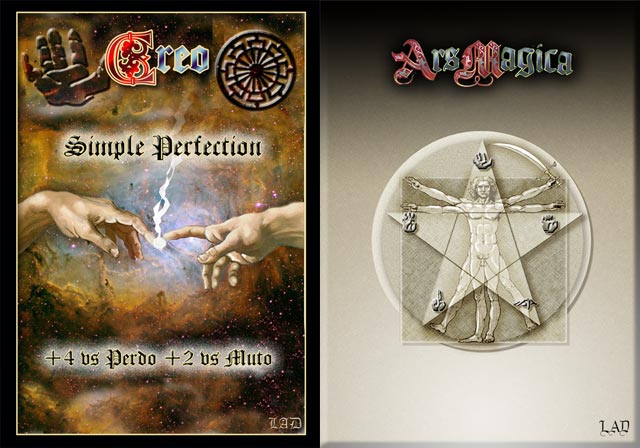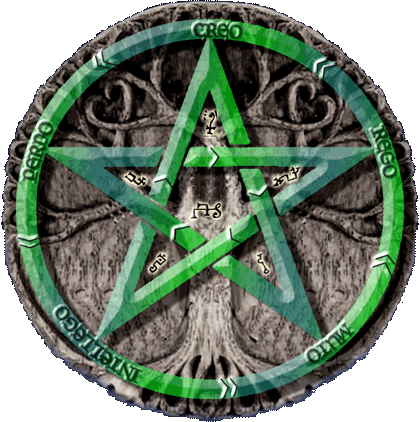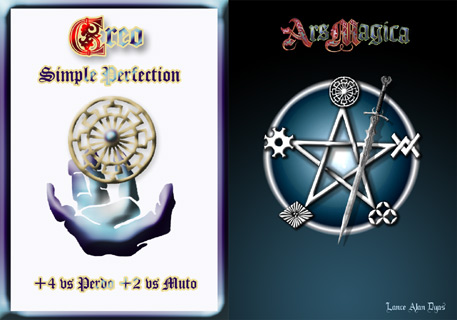

These supplemental rules can add the flavor of wizardry to Ars Magicas physical combat (or perhaps spice up Certamen). Its' main effect should be to encourage more descriptive and interesting combat.
This is in some sense the direct inheritor of ideas from the Decision Driven Rolegaming Engine. The specific Ars Magica context is very appropriate and feels natural. -Lance Alan Dyas
This specific idea came to light when a system for using techniques and forms for mundane combat was mentioned on the Ars Magica mailing list. The initial idea, involved restructuring of Ars Magica's combat system with its' magic system serving as a model. Hence, Technique + Form applied to casting a defined or improvised spell translated to Combat Technique + Weapon Skill to perform a defined or improvised combat maneuver. The consistancy between game mechanics for dealing with mundane and magical combat while nice, was heading toward a complex combat system which was ill suited to Ars Magica.
Consequently, these rules concentrate on two uses of Combat Techniqes (these named after and fundamentally similar to the Magical Techniques). The first being their use as a preferred fighting style and the other as a description of currently used technique. Both uses simply provide bonus's to combatants rolls (Attack Defense, Damage and Soak)
This usage requires each character be assigned a preferred style (Creo, Rego, Muto, Intellego, Perdo). This is generally established when they learned to fight, and associated with their personality and/or their teaching. The Dominance Pentagram is then used to define modifiers to all combat actions between any given pair of combatants.
The degree of effect this style dominance has should be less severe than that which occurs due to the techniques of individual actions so grants only a +2 bonus to the combatant whose preferred style is counter clock-wize of his adversaries. Clockwise dominance via the inner star only grants a +1 bonus as appropriate. Hence Creo vs Perdo vs Intellego vs Muto vs Rego - etc grant +2, Creo vs Muto vs Perdo vs Rego vs Intellego vs Creo grant a +1 .
This combines well with Preferred Risk / Aggression option described below they both allow your combatant to be categorized allowing you to visualize their battles in a general way even if fighting is an infrequent thing.
The Magical Connection: Generally ones style at fighting is independent of the Techniques used in magic. But the connection between personality and Wizardry is very strong. Mages "may" find their preferred fighting style shift strangely to match there highest magical technique. Or different houses may be drawn to different styles, for instance Criamon and Bjornare seem inclined to the wild fighting style of Perdo whereas Bonisagus tend towards Intellego ( or Creo) and Merinata like (Muto) and Quaesitors (Rego), Jerbiton (Creo) etc. This at least gives a stereotype to work from.
Personality Traits: are explicitly associated with fighting style and to show how check out this list of conflict / problem solving oriented personality traits.
This variation involves secret selection of a different technique each round generally using 5 suitably marked cards one of which is played by each player face down each turn. This can be allowed to have more dramatic effect as a character isn't "nailed down" atleast not very long by a single choice. The outer circle is a "definite bonus" (+4) in counter clockwise direction , also the star pattern grants a lesser bonus" (+2 ) in a clockwise direction. When the cards are turned over the maneuver should be described in a suitable fashion. Below under the name of each technique is information to help this part of the process.
Download Printable Cards for use with the (CUT) Currently Used Technique
Realistically most combat strategems contain elements of all techniques, for game play characterisation obviously we are simplifying by choosing only one or optionally 2 techniques to characterize 5 to 20 seconds of action.
Normally when using the CUT method, preferred style is expressed in a characters active choices but for added detail and impact you may even combine both "Preferred Fighting Style" and the "Currently Used Technique" options.
Another option which may actually make description easier, involves choosing a technique for attack and defense actions separately this is particularly appropriate if you generally use Ars Magicas separate defense roll option.
 Creo / Perfection & Truth
Creo / Perfection & TruthThis style invokes the perfect and flawless, it's very much a "schooled in battle" style. If your are closer to perfection than your opponent, you will win. Efficiency as in economy of motion and precision of form is emphasized. This is perhaps the most internally aware style its practitioners often enter a state of self hypnosis from which they express confidence and truth of form. Your attacks often get through your opponents defenses by brute force.
Quote: "May the better man win. "
Maneuver Types: Mostly fast straight forward, relatively simple and efficient maneuvers which don't involve too much interpretation of your opponents current actions. Whatever moves this style is applied to the focus becomes correctness of form.
Examples: "basic strikes" "stopping parries" -> ie "blocks ", "pure retreats"
Flaw : somewhat predictable it is what it seems.
Adversary Styles : To Intellego it seems like you are broadcasting your next move, though they are less able to exploit it than Rego. You cut through Perdos chafe and tend to ignore Mutos deceptions completely.
Benefits: amongst the most precise, and decisive very quick often the least fatiguing of effects.
 Rego / Control & Redirection
Rego / Control & Redirection This style is about mastering your opponent and accuracy. Compelling / Redirecting the actions an opponent in a directed fashion can defeat them or make them easier to defeat. These moves are themselves strongly adjusted and controlled to suit the immediate situation and adversaries apparent position.
Quote: "Playing your opponents game is a guaranteed way to loose, make them play yours."
Maneuver Types: These maneuvers try to use and change what your opponent is attempting into what you would rather it be. Sometimes the real benefit kicks in next round.
Examples: "locking weapons" "diverting parries" and "dodges","planned retreat / escapes", "throws","maneuver opponent onto bad ground"
Flaw: assumes accurate understanding of your opponents game...
Benefits: some of the most accurate of actions and can be very devestating in effect.
 Muto / Change & Misdirection
Muto / Change & Misdirection Complexity is a part and parcel to this style. All ones actions are indirect if not completley changing from one moment to the next. This style is about misdirection even when it isn't out right deception. Your moves are sometimes intentionally complex and cannot be assumed to be what they appear at first glance. In wrestling this is the slipperyness your adversary cannot get a grip on.
Maneuver Types: This includes some of the trickiest and complex maneuvers.
Quote: "Assuming too much will be your downfall"
Examples: "spinning feint"; "subtle feint" various "fakes" and "flourishes" "blinding powder in the eyes" and other combat "tricks" as well false openings like "trapped doe" and pretense of inferiority or superiority. "change ups" and "weapon switches".
Adversary Styles : Intellego is the only style which really knows what this style has in store, Rego falls hook line and sinker or at best assumes badly. Perdo can't resist nibbling, but Creo out right ignores the trickiness and complexity.
Flaw: Much effort is spent to no real end these are often less efficient than other styles (and even a subtle feint is planned and can be read by those who chose).
 Intellego / Patient Perception
Intellego / Patient PerceptionThis is considered by some the thinking mans style for you analyze the moves of your opponent, predict them, then finally act with certainty. All acts in conflict involve an element of dissemination and if you know your opponents plans your maneuvers can undermine and exploit them completely. If you are its master there is no "fog of war". This style tends to appeal to the patient and those who refuse to be fooled.
Quote : They who know the truth cannot be decieved "
Examples: "reading" and "scanning" of your adversary "looking for opportunities" , finding openings "for attack" or "for escape", "finding the best position of advantage.
Flaws: Takes the most time ensuring certainty... often little is left and assumes a planned action of some sort from ones adversary so continually adjusted plans(Rego) and unplanned actions (perdo) defeat it.
Benefits: Intellego effects normally are most often useful "next round" - ie they carry over allowing results more extreme than otherwize achievable.
 Perdo / Wild Destructiveness
Perdo / Wild Destructiveness This is the style in which one cultivates instinctual and to some extents "natural" "ultimately quick" and "wild" destructiveness. Your attacks get through the cracks in their defenses not by aiming but rather by attacking everywehere. This is sometimes considered a barbaric style, even anti-intellectual, but fighting is a very solid instinct amongst all living things. You make your adversaries world so dangerous their indecisiveness will kill them. Its masters are more ofen comfortable with improvised weapons than many.
Quote: "You will wreap the whirl wind"
Examples: "Wall of Steel"; "Fancy Footwork" "Bob and weave","Wild Flurry","multilimbed / multiweapon barrage"
Flaw: lacks true follow through and tends to be interupted by resolute quick planned actions (creo and muto to a lesser degree.)
Benefits: Fastest and "truly" unpredictable this style is often dangerous even in defense.
This is less central to what is being presented here as it is independent of the Techniques. However in the context of introducing more interesting choices it stands to reason one might also want to allow more reasonable ones. Ars Magicas combat currently gives 3 wildly dramatic options in regards to "aggressiveness", they are acting "fully balanced ", "All out Attack +6" and "All out Defense +6". These are ahem not really realistic and the lack of subtlety deprives players of choices in expressing their characters personalities in conflict.
The method of making this choice more appropriate is very simply to allow aggressiveness / defensiveness a gamut of values. This modifier should affect the attack and damage roll / as well as defense and soak rolls ( In real life when you point deadly weapons at people there is still a chance they will get hurt even when you are just defending). This is analogous to Currently Used Technique and can chosen / modified each turn. Used in combination with Preferred Aggressiveness described below I suggest a range of +4 to -4, as this allows preferred Aggressiveness to account for the final extremities of action (if you feel player choices should actively express the characters preferrences allow +6 to -6). Six sided dice of differing colors could be used to nicely record the aggressivenes of story guide controlled characters.
Notice "Aggressive ie Risky Defenses" keep you closer to your adversary to maintain a position of attack and are more often parries and blocks.
This option is favored for use with the Preferred Fighting Style. Aggressive tendencies like Preferred Style are similarly affected by both training and personality (though don't always cement themselves until the influence of some initiating experience).
Very Bold : +2 Damage, -2 Soak , +2 Attack, -2 Defense
Risk Taker: +1 Damage, -1 Soak, +1 Attack, -1 Defense.
Balanced Combatant: The conflict style is generally encouraged by many soldierly training programs, and is never the less not as common as you might think.
Cautious: -1 Damage, +1 Soak, -1 Attack, +1 Defense.
Very Cautious: -2 Damage, +2 Soak , -2 Attack, +2 Defense.
The above modifiers should be calculated ahead of time and integrated into your combat numbers.

Here are a few descriptions which give some ideas about how the various combative styles interact from the characters point of view. We are certain your imaginations can do better within the context of your actual game play. (coming soon in game examples from player / story guide point of view).
Ars Magica has variable length rounds but gives no clues regarding the basis of that variation the Techniques can help answer that.
One thing to remember in your descriptions is a round of combat is a variable length of time and which combination of techniques can influence exactly what that variable time is typically if there is a strong dominance involved the round goes quicker and a moderate dominance is still faster than a no dominating strategy situation. Predominantly defensive behavior generally takes longer to resolve an action.
One way of managing this in an "ahem" far too mechanical fashion is to have the strategy of each combatant contribute to the time of resolution according to their position on the circle of dominance... Perdo adds 0 seconds, Creo adds 1 second, Rego adds 2 seconds, Muto adds 3 seconds and Intellego adds 4 seconds, a tied strategy is 12 seconds base, a somewhat dominant strategy has 6 seconds, a fully dominant strategy resolves fastest and is based only on the sum of the two strategies contribution
The answer is that it is both.. The risk the defender spent is the basis of position gain and the risk their adversary spent is the basis of their imbalance. Imbalance is in fact more significant on many fronts as it impairs your ability against any adversary not just the specific one. ( It is reasonable to halve imbalance or allow it to be reduced by 1 per 2 levels of skill - though the latter would be double dipping)
Imbalance may represent other things than being "physically imbalanced" including loosing your weapon, temporary blinding, being stunned etc. It's all right to use your imagination.. ) Attacks like trips and throws which target your opponents balance may seem to do all imbalance, but often leave you in a better position to exploit that imbalance as well.
Carrying over the benefits of one round to the next is the standard affect of an Intellego Technique) but can sometimes be a unplanned side effect of creo and perdo, or intensional effect of others. In any event the player may choose whether they wish to apply the impact of the action to this round or make it carryover. Most defensive actions are purely carryover.
These rules can indeed be used in Certamen, and some might say it is doubly suited since this is really where combat with mages is usually going to occur and hence using the Techniques to describe it is most appropriate. No matter what the tech-form combo is the players choose a "usage technique" or "application method" . If you Creo a cage of bone it would probably be a Rego application of a Creo Animal. Though actually a cage effect is probably an incarnation of "Carry Over" results.
This idea, the use of hand gestures to make the conflict fast and furious, is interesting in and of itself, and it is ideally suited for Live Action Role Playing, this effectively a Non Card Implementation not specifically geared for roleplay just quick and easy fun that my 6 year old helped me play test ;-). I put it on my Magia Draconis page in more detail because the gestures are both smooth and appropriate and not those of Ars Magica.
"Results" can be much the same with differing methods / styles of performance. For instance "Kicking somebody in the leg", may occur because of a "multilimbed barrage" or a "take the best opening to put him off balance" or "do a leg sweep" or even the explicit "front kick to the shin". The same result can come up under different styles, it is important to differentiate result and method/technique.
There are overlaps in the concept and descriptions of muto and rego (check the Ars Magica texts muto even uses the word control and rego the word change). An adjusted attack which is changed in response to what fairly obviously appears to be happening is Rego, where as an attack made complex enough by changes and indirection hence requiring special effort (Intellego) to predict is a Muto.
Additionally Rego contains elements of perception just as Intellego, but it responds to what it sees, pretty much as it sees it, this different than Intellego which makes certain.
Drawbacks : It can involve an element of desription and awareness of style / technique for physical combat that your players are probably not be used to.
Impact: the CUT implementation using the above numbers +4/+2 has a typical impact approximately the same as a simple roll might have.
Perhaps the above could have been written (in Ars Magica Style) as a treatise on combat styles which represents how Hermetics who use weapons understand the art of "Steel, Flesh and Blood". However as real styles which mechanically affect play in subtle or not so subtle ways as described above it can be more. In any event understanding conflict in terms of them can bring additional connectivity between the magic and mundane combat in your game.
Back to the Decision Driven Rolegaming Resource Center
Also check out A simpler french version by Jeremy Provost located here